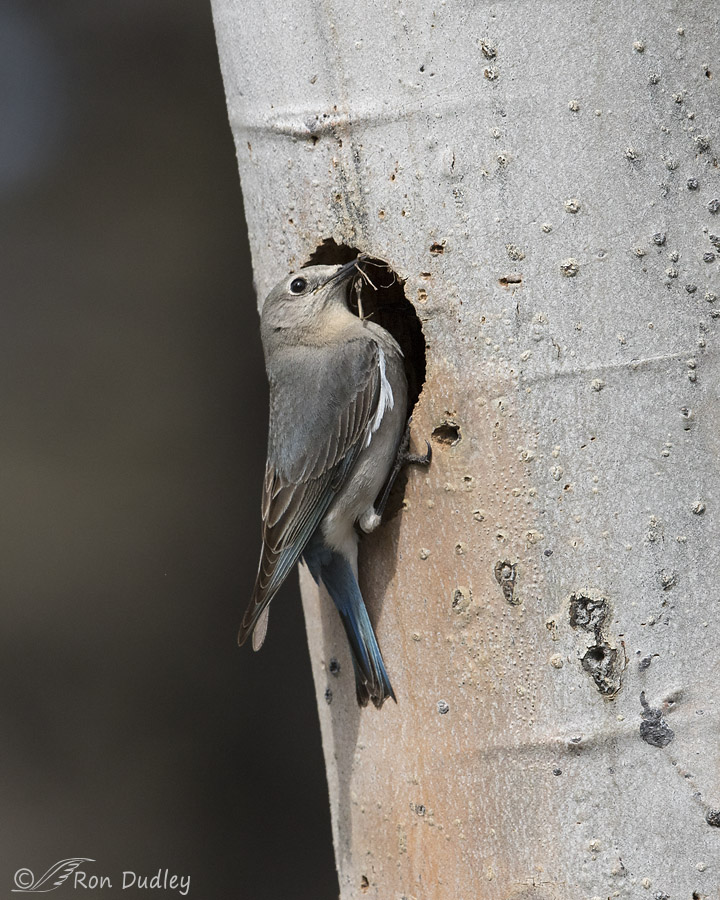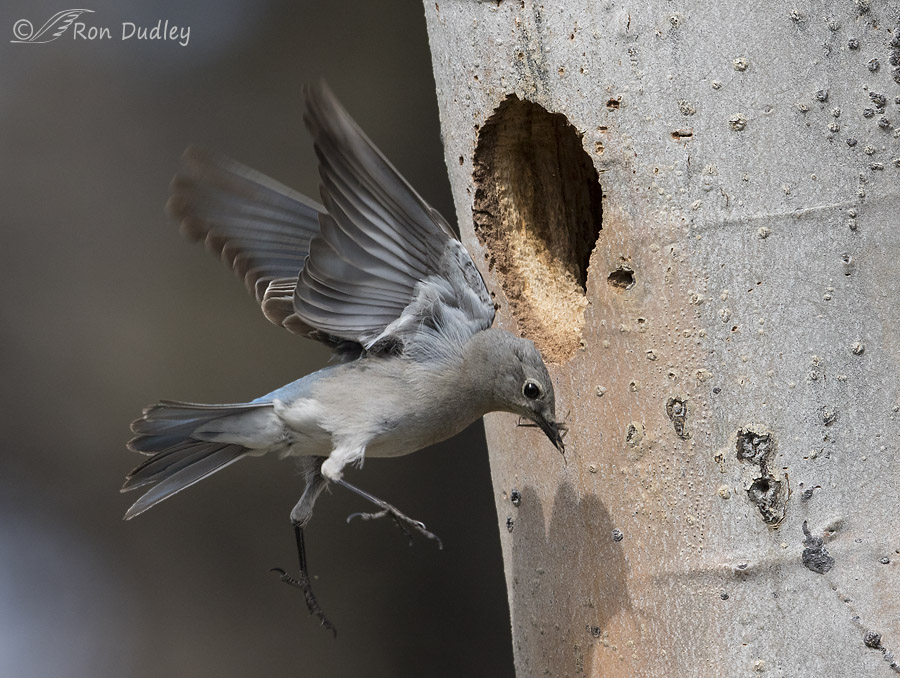It’s surprisingly difficult to anticipate direction of take-off, even as birds leave the entrance to a nest cavity in a tree. One might think that the physical presence of the tree itself would make it relatively easy to catch the bird in the frame as it leaves because the tree reduces the direction they can go by about half. But birds are so creative in flight and it all happens so quickly that capturing them at that moment is still a huge challenge.

1/2500, f/6.3, ISO 800, Canon 7D Mark II, Canon EF500mm f/4L IS II USM, not baited, set up or called in
This is the female Mountain Bluebird at one of the nest cavities in an aspen 6 days ago in Clark County, Idaho. At this point competition for the cavity between the bluebirds and a male Northern Flicker was still pretty intense but for a variety of reasons I believe that the flicker and its eventual mate will likely be the tenants of the cavity this nesting season. This is one of only one or two instances where I saw either bluebird bring nesting material to the cavity.
I expected the female bluebird to enter the cavity with the nesting material but birds are very unpredictable and I was after flight shots at the time so I tried to be ready for anything. She had a surprise in store for me, on two levels.

1/2500, f/6.3, ISO 800, Canon 7D Mark II, Canon EF500mm f/4L IS II USM, not baited, set up or called in
Not only did she fail to enter the cavity but she took off from it in an unusual manner. She simply pushed herself backwards from the nest hole and then dropped almost straight down in front of the tree, a maneuver I hadn’t seen before and one I certainly didn’t anticipate. I was lucky to avoid clipping any body parts even with my teleconverter removed (I have no more room at the bottom of the frame).
I’m constantly amazed by the flight creativity of birds.
All this may seem like much ado about nothing but as a photographer who regularly strives to capture birds in flight I need all the “edge” I can get (especially since I don’t shoot setups) so I think about and even study this stuff a lot. And the reasons for my intense interest in bird behaviors are, at least in part, selfish ones. To some degree the more I know about them the better bird photographer I can become.
Ron


Such beautiful shots and nice and close!
I’m going to shut up now…I’ll bet EVERYONE is sick of me…can’t blame them!!!! Soory folks…..
Never ever sick of you. Your comments and the evil iPad are a joy and a delight.
I second Elephant’s Child.
That’s no joke…staying on the road. When I first saw the Tetons, I drove right off the road 3 or 4 times..havecalsoo almost driven off of various other roads when I spotted something unusual or interesting. My husband prefers to do the driving, but he drives right by the best stuff….I hate that!
That Mia woman is a pretty darned good teacher, too. I know she’s been teaching me plenty…does more with every blog!!!
She’s taught me a lot too, Patty. Most of what I know about processing I’ve learned from her. She also knows bird ID better than I do. And she has eagle eyes so she spots birds better than I do – my main job is just to try to stay on the road as I drive…
Susan(AKA Rocky)–I think of “teacher” as a verb, as well as a noun…As much a matter of “doing” as a profession. You teach, therefore you are a teacher…never mind the “professional” part of it. Some of the finest “teachers” I know have no “professional academic” teacher training…and some of the worst have credentials up the kazoo! I can think of one guy right now, one we call “Johnny Van” who is one of the wisest, most knowledgable naturalists i’ve ever met, who can teach circles around most “trained, professional” wildlife “teachers”…he claims he never did very well in school. You teach? You’re a teacher….welcome to the club!
Very, very well said, Patty.
Thank you, Patty. I am in very, very good company here!
Learning and teaching are precious gifts in stunning wrapping. And which is the gift and which is the wrapping varies from day to day and moment to moment. Another gift.
Thank you for watching for the unexpected – and sharing the joy.
An interesting way of saying that, EC. I agree.
Fantastic shots! A bluebird shifting into reverse!
First reverse, and then down, Jane. None of my transmissions ever had a “down” gear…
Economy of motion. Love it.
Thanks, Arwen.
I’m so glad you made those choices! As a retired teacher myself, I know what you mean by how “rewarding” teaching can be…you not only get to share with and, hopefully, enhance the lives of others, but you LEARN so much!!!
Exactly, Patty!
Patty, that is so true! As pictograph tour guides we are always teaching people about our park, but those people many times teach us things, too. I’ve never been a professional teacher like you or Ron or my husband, but teaching has been part of what I did with my career and it has always been wonderful to see what happens when people ‘get’ a concept. My favorite moments from being a tour guide are when the lightbulb goes on for people who have lived here for years, when we show them where the desert rain smell comes from (Creosote Bush). It just makes their day. And that makes my day.
” It just makes their day. And that makes my day”
Yep!!!
I’m glad you were prepared and able to get this shot. It’s beautiful.
Me too, Susan. Thank you.
You mentioned “nerve synapse connections” in your response to Dick, a function I find incredibly fascinating…How I would LOVE to SEE what happens with those neurotransmitters…during response and learning situations…and know more about them–what they really are, how they actually work and why, what enhances their effectiveness and what inhibits it, what can be done to enhance or “fix” their functioning. Neurology and genetics are so amazing and magical!! The living body is such a mysterious, incredible organism…regardless of size or species! No wonder you chose Biology…It will always continue to amaze, enchant and entertain you as it continually keeps unfolding its wonders (for me , too!!! )…
“No wonder you chose Biology”
You list some of the very reasons why I did just that, Patty. I made two lucky choices in my professional life, biology and teaching. Either one without the other would have been significantly less rewarding.
WOW – I’m with you Ron, and Patty, similar reasons that I went into teaching! A tad different in some respects, but basically extremely similar! Primarily I was a bird bander, taught in a Museum wanted to get in the classroom to practice and share my love of biology, natural history and the ocean.
Without committed and skilled teachers we’d be in an even bigger world of hurt than we are. I guess that’s pretty obvious but so many folks just don’t get it…
Ron:
Interesting behavior. A positive take on the lack of predictability – if the take-off behavior of birds were more predictable, many of your flight shots would not be unusual; many photographers would have comparable images. And I would have a decent shot of a Scissor-tailed Flycatcher, which I do not.
Dave, I suspect you’re like me in that the difficulties of getting good flight shots is part of what makes us keep trying. If it were easy it wouldn’t be as much fun. Or as interesting.
Good luck with the Scissor-tails!
One of the most wonderful, most valuable aspects of your incredible photography is that you capture and “freeze” behaviours we might not notice, that might happen too fast for us to fully observe, or that we might overlook…your photos allow us to not only see these behaviours, but to look them over and over, to study them and learn from them. As I’ve said before, I’ve never seen one of your blogs that wasn’t beautiful, interesting, informative, and exciting.I think you’re keeping this tired, old brain functioning! You’re still at it, still teaching( and learning), only now your class is world wide!!!
Patty:
“I’ve never seen one of your blogs ….”. Thanks for saying that. I’m sure many followers feel that way, but fail to express it so nicely.
“I think you’re keeping this tired, old brain functioning!”
It keeps this tired old brain semi-functioning too, Patty (though I have to admit I just took a morning nap. It’s raining hard here and listening to it makes me drowsy).
I appreciate the kind words. Yours too, Dave!
Hi Ron, loved the capture. I know it’s exciting for you to see any kind of movement or activity you’ve never seen before – just warms the heart. Also have to admit that I just looked thru your Swainson’s Hawks mating series from yesterday. I just love it & know I will go back to it many more times.
You’ve got me pegged, Jo Ann. I do like to see new things in the field. And then try to understand them as best I can. I have a theory that it slows down the aging process just a bit… 🙂
I think your amazement & love of wildlife comes thru in your blog, Ron & is a reason why I enjoy following your blog. Also being physically & mentally active will keep you sharp – just like your photos!! LOL!!
What a surprise! Just proves “you never know”!!! I’ve never seen a bird push off backward like that before. Turn and push off, yes, but not push backand drop like that! I wonder if you, or anyone else, will ever see that again…
I don’t know, Patty. Perhaps it happens more often than we (I) think and we just usually don’t notice it when watching with the naked eye. Another advantage of photos and long lenses…
Beautifully detailed shots Ron
Charlotte
Thanks, Charlotte.
Neat
I’d wager there are some birds that are learning new things in flight. I’d almost bet, of course no way to prove it, that you documented a new trick for this individual female.
At any rate great shots.
Thanks, Dick. I suspect a neurobiologist would have a blast studying the new nerve synapse connections that form as these birds learn new tricks like this…
Very interesting Ron. Was the hole high? If it was, would it have been just easier for her to drop rather than push off?
At any rate beautiful shots, tack sharp!
Dick, I’d estimate that the hole is about 6-7′ off the ground.
It may or may not have been easier to drop, I just don’t know. What I do know is that in the many hundreds of times I saw birds (2 species of sapsuckers, flickers, bluebirds, nuthatches, swallows, chickadees etc.) fly off from this hole over two seasons, whether clinging to it from the outside or leaving the cavity itself, this was the only time I remember seeing this particular maneuver.